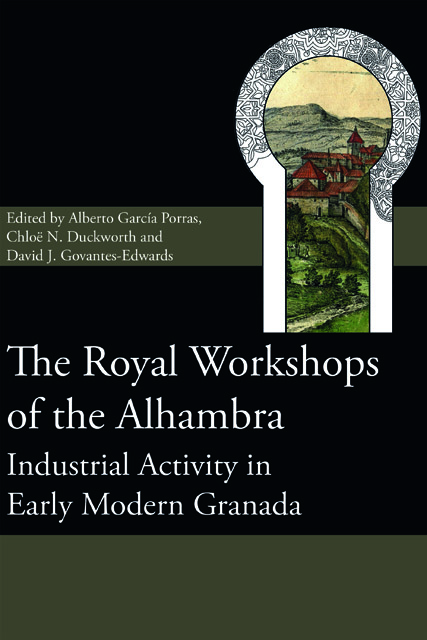Book contents
- Frontmatter
- Contents
- List of Illustrations
- List of Contributors
- Acknowledgements
- Foreword
- Introduction
- 1 The Secano: the city of the Alhambra
- 2 A holistic and reflexive methodology for the archaeological investigation of pyrotechnological activity in the Alhambra
- 3 The modern kilns
- 4 Geophysical and geochemical exploration of the industrial areas in the Alhambra
- 5 The excavation of the area of the Secano in the Alhambra: Trench 1
- 6 The excavation of the area of the Secano in the Alhambra: Trench 2
- 7 The pottery
- 8 Glass in the excavation of the Secano, the Alhambra
- 9 Furnaces at full blast: the demand for architectural ceramics for construction in the Alhambra (16th and 17th centuries)
- Conclusions
- Index
4 - Geophysical and geochemical exploration of the industrial areas in the Alhambra
Published online by Cambridge University Press: 20 December 2023
- Frontmatter
- Contents
- List of Illustrations
- List of Contributors
- Acknowledgements
- Foreword
- Introduction
- 1 The Secano: the city of the Alhambra
- 2 A holistic and reflexive methodology for the archaeological investigation of pyrotechnological activity in the Alhambra
- 3 The modern kilns
- 4 Geophysical and geochemical exploration of the industrial areas in the Alhambra
- 5 The excavation of the area of the Secano in the Alhambra: Trench 1
- 6 The excavation of the area of the Secano in the Alhambra: Trench 2
- 7 The pottery
- 8 Glass in the excavation of the Secano, the Alhambra
- 9 Furnaces at full blast: the demand for architectural ceramics for construction in the Alhambra (16th and 17th centuries)
- Conclusions
- Index
Summary
Traditional approaches to geophysical prospection tend to limit the usefulness of this set of techniques to the identification and outlining of archaeological sites prior to excavation. However, recent developments have highlighted the advantages of more in-depth, multi-scale, and reflexive perspectives which enable not only the identification of archaeological sites but also their characterization. This paper presents the geophysical (magnetometry, magnetic susceptibility, resistivity, GPR, etc.) and geochemical (handheld portable X-ray Fluorescence – pXRF) methods deployed in the area of the Secano in the Alhambra for the investigation of pyrotechnological industrial facilities including pottery kilns and glass/glaze furnaces. The selection of techniques employed was tailored not only to confront the peculiar geological and archaeological conditions prevailing in the site but also to collect meaningful information about these facilities even before the commencement of excavation. Importantly, the process was not understood simply as preliminary to excavation, but also continued during the excavation of the trenches. Handheld pXRF and topsoil magnetic susceptibility were used throughout as ways of keeping the excavators informed about the nature of the fills they were removing from within the furnace structures, as it was rightly suspected that these contained substantial traces of some of the chemical compounds used in the glazing of pottery (copper, lead, manganese). This was framed as a reflexive strategy that could, in contrast with analysis results obtained in the laboratory post-excavation, help to direct excavation strategies.
Keywords: Late medieval and early modern Alhambra; archaeological survey; multi-scalar survey; reflexivity.
Introduction and Theoretical Background
Prospection is a key part of archaeological practice. A wide variety of geophysical techniques have long been part of the standard toolkit of archaeologists, with an increasing emphasis in the past few years on the use of multi-instrument approaches. In general, these techniques are used to identify sites – that is, to determine their absence/presence or to draw their general outlines – prior to excavation. The next step of methodological development involves exploring to what extent these techniques can go further in helping us to not only identify archaeological sites but also characterize them. The application of, and experimentation with, techniques creates data that can be used in concert with that obtained by excavation to enhance interpretation.
- Type
- Chapter
- Information
- The Royal Workshops of the AlhambraIndustrial Activity in Early Modern Granada, pp. 49 - 72Publisher: Boydell & BrewerPrint publication year: 2022
- 1
- Cited by

